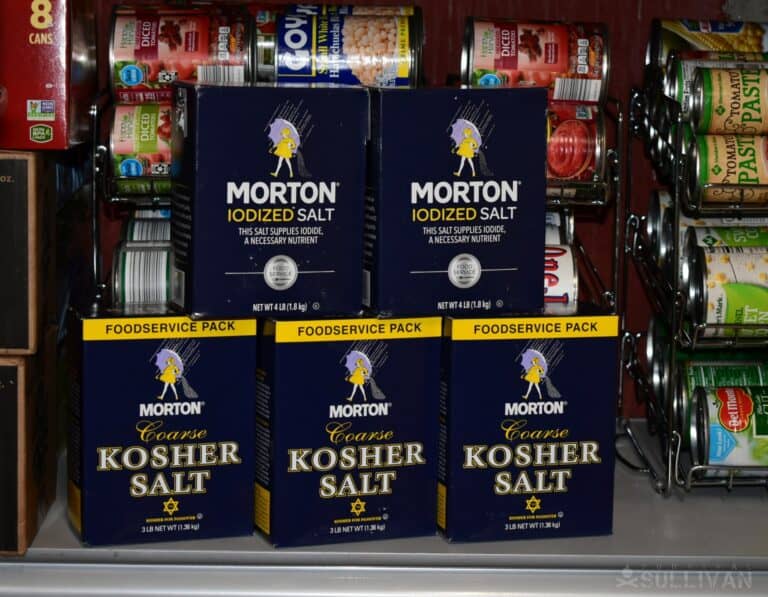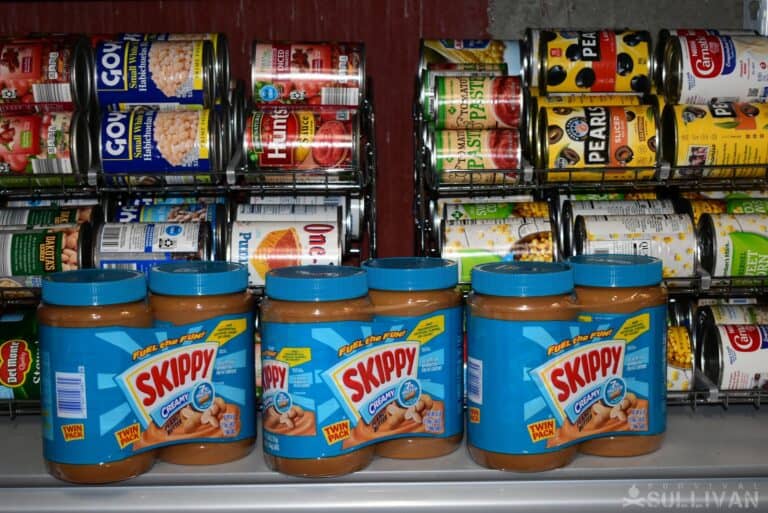One of the most exciting things about prepping is that we get to give our brain a good workout by imagining in detail how things will go down. Based on what’s happening to other people around the world every day, we’re trying to determine when and how things will go down for us.
Experts recommend bugging in as the safest option for most people unless your current home becomes unsafe or you have a bug out retreat well-prepared in advance of a crisis.

Well, let’s say the disaster or crisis has already started. We just heard an announcement on the radio, T.V., or emergency radio.
We know we only have a few more hours until we should either be safely bugged in at our home or as far away from that place as possible. You have time some to go to the store and get anything you want. What will you get?
Note: we’re also assuming it’s SAFE for you to do this. When things go downhill, going to the store could prove extremely risky as it could be crowded, and fighting for supplies could get you injured… or worse.
But let’s say the nearest supermarket is safe, you have enough cash stashed away to use for supplies, and you can get anything you want.
Maybe you live in a small town or maybe the others are unaware of what’s about to happen. Maybe it’s across the street from you and you can see that there’s no one around.
Keep in mind that, if you’re bugging in, for example, you might have to spend some of your time barricading yourself inside, moving all your valuables, and so on.
So, 3 hours to SHTF. It’s safe to go to the supermarket. What do you get?
It all depends on where you’re at with your preps. If you’re bugging in but half of your preps are at your bug out location, you might lack important supplies you need to have right away.
If you’re a newbie and haven’t gotten the chance to grow your stockpile to the level you intended it, again, you might need critical items.
And if you’re already fully prepped and ready for anything, you should still empty the shelves simply because you can and you know that eventually, those extra supplies will come in handy.
Which of the two scenarios below applies to you? Depending on your answer, when you rush with a cart inside the store, you’re going to have to look out for different items.
Scenario A: You’re in Need of Essential Items
In this case, you’re gonna need a good list of emergency essentials so you can quickly figure out what to get. Of course, getting literally anything can also work but you definitely don’t want to leave anything important out.
In an emergency situation, it’s a proven scientific fact that many people experience memory loss or are unable to think clearly, so it’s critical to have a list prepared in advance that you can refer to.
Focus on:
- food with a long shelf life
- canned foods
- peanut butter
- nuts and seeds
- condiments
- flour
- rice
- beans
- oats
- powdered milk
- cooking oil
- protein / energy / granola bars
- instant potato flakes
- trail mix
- dehydrated fruit
- even some MREs if you have the money and you can find them
- food with a short shelf life, too (you can eat it over the next few days)
- bottled water
- medicine and first aid supplies
- alcohol wipes
- antibiotic cream
- aspirin
- Ibuprofen
- hand sanitizer
- and lots of bandages of all shapes and sizes.
- fuel, motor oil, transmission fluid, in case you’re bugging out
- pet food
- barricade supplies such as lumber, screws, plastic, and nails
- auto parts, especially fuses, clamps, hoses, etc. for making repairs
- Paracord
- anything needed to protect yourself and your home
- toilet paper, of course
- Feminine hygiene products
- Flashlights, headlamps, and lanterns
- Batteries in a variety of sizes (preferably rechargeable)
- Trash bags to use for waterproofing supplies, for containing trash, bagging debris, and bagging human waste if needed
Well, this just looks like a regular prepping list and it is but it’s worth repeating it as many times as possible. But if you already have all these things, what else should you get?

Scenario B: You’re Already Stocked Up
If this is you, congrats. But as long as you have the time to make a trip to the store and it’s safe, why not get some of these as well:
- lots of insulation
- warm blankets
- tools from the hardware store
- comfort foods (only if there’s time): coffee, chocolate, juice powders, popcorn, hard candy, caramels, chewing gum, liquor (whiskey, vodka, brandy, rum), tobacco, wine
- print out survival articles and ebooks (if you haven’t done so already) to have that knowledge with you in case the power grid goes down for an extended period of time
- as many perishable things as possible to eat over the next several days so you delay using your stockpile
- also, focus on things that are hard if not impossible to get, replicate, or replace post-collapse, such as:
- canning jars and jar lids
- coffee filters
- Ziploc and Mylar bags
- chainsaw
- and so on.
All in all, just get as much as you can as fast as possible. In this case, you don’t even have to worry about what to tell cashiers when you’re leaving the store with that much stuff.
You might want to just warn them that the last thing they should be doing in times like these is working.
The Dangers of Last-Minute Survival Shopping
As I stated before, there are certain dangers to be aware of before venturing into the supermarket. It’s crucial to be aware of these because failing to do so can get you in a lot of trouble. They are:
- the fact that the store may be, in fact, crowded or can become so within minutes, trapping you inside
- you might need to be doing other, more important things (see list below)
- you might get into a fight or confrontation over supplies on your way there, or on the way back
- in the heat of the moment, you might get into a car crash
- thieves could sneak up on you from behind in the parking lot, taking away all your supplies
- the supermarket might be already closed or looted which means you waste valuable time
- you might have to face roadblocks and police checkpoints
What Else Should You Be Doing Before It Hits?
Obviously, everything we said before should only be done if you have enough time AND if everything below is taken care of. Only go to the store at the last minute before a crisis if:
- your home is prepared for you to barricade yourself and family inside or getting your bug out vehicle ready,
- your bug out vehicle is ready and prepared for you to leave within minutes or seconds if needed
- family members are ALL safe and ready to bug in or out with you (if you have a family emergency plan that you can put into action, even better),
- communications methods are functional and every family member knows how to use them,
- bug out route, one that’s quick, safe, and ideally, takes you to your bug out location, has been decided
- safe room is ready as well as your emergency escape routes from your house (so you’ve got options in case of a home invasion),
- guns, food, water, and generators are hidden so they can’t be easily taken away from you,
- rifles and other weapons are ready and loaded,
- Spouse or family member has already or is collecting as much water as you can inside your bathtub, buckets, barrels, and every pot you’ve got.
Final Word
I guess the big takeaway from this article is that things may not look that bad and even if we are already prepared, we have to take advantage of the opportunities that arise.
If that supermarket is still full of supplies and no one’s is aware of what’s about to happen, you should definitely consider taking advantage of the situation and stocking up. FAST.

And, to make things easier for you, I put all of these items in a convenient PDF that you can print out an use when the time comes. There’re also plenty of empty spaces on the list on the second page. Use those to fill out with your own things you’re thinking of getting.

My dad was military. My grandfather was a cop. They served their country well. But I don’t like taking orders. I’m taking matters into my own hands so I’m not just preparing, I’m going to a friggin’ war to provide you the best of the best survival and preparedness content out there.


Cast iron cook ware, because the modern ceramic coated stuff doesn’t work towell for a long time on an open flame, also traps gunpowder/ pyrodex and bb’s nickle or copper plated
I have been prepping for decades . I use cast iron cook wear for cooking. I rotate my preps and over the years I have added things I couldn’t afford when I was younger. I think everyone needs to be prepared for some disaster. I like the list as it helps keep people on track about the important things to consider. and even if the shtf doesn’t happen next month we still have to contend with plenty of other disasters .
It is good to keep enough cash on hand to buy what you might need last minute. Especially if grid or internet is down. Even to buy a camping trailer off Kijiji (Craig’s list). I would also keep around camo spray paint, lots of salt to keep meat, yeast and flour, wood stove and wood, propane and stove. I have a family of 5, so a couple backpacks aren’t getting us very far. we have a cargo trailer with all our camping gear in it, including a wall tent, wood stove etc. Depending on the situation, most of the time we would be better off at home though. We know the lay of the land, have our resources, etc. We’re working on putting in a hand pump on an abandoned well so we can have a back up water source. Rain water tanks are also crucial.